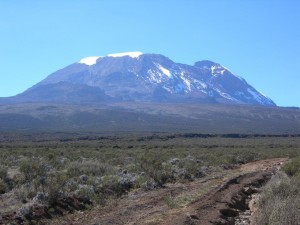Rongai Route
To climb Mount Kilimanjaro on the Rongai route used to guarantee you a quiet trek away from the masses.
 The Rongai route is often seen as a remote wilderness experience and for much of the year it still is.
The Rongai route is often seen as a remote wilderness experience and for much of the year it still is.
But watch out: over the last years Rongai has seen a surge in popularity.
If you climb Kilimanjaro on the Rongai route during the main season (August to mid October) and if your climb starts on the usual group departure day, you may find yourself in the middle of a pretty big crowd.
Most groups depart Sunday, so people can finish work Friday, arrive Saturday, start climbing on Sunday and be back in the office the Monday after...
Still, Rongai remains much quieter than the popular Machame or Marangu trails.
It also has several other advantages that should make it one of your first choices:
- Rongai is the easiest route up Kilimanjaro, in some respects easier than Marangu. Rongai has excellent success rates.
- Rongai is the only route that approaches Kilimanjaro from the north. You have to descend on the Marangu route on the southern side, so you get to see both sides of the mountain.
- The northern side of Kilimanjaro is drier. You are unlikely to have to slosh through mud and drizzle on the first two days (not unusual on any of the other routes).
A drawback is that you get to the other side of Kilimanjaro, so you have to drive for a couple of hours. Thus Rongai is more expensive than a six day trail on Machame or Marangu.
The other disadvantage is that the Rongai route has a reputation as being less scenic than other routes.
However, that applies mostly to day one, when you will be trekking through fairly open country instead of the dense rainforest. But you'll see the rainforest on your descent! You are not missing out on anything.
The Rongai route has several variations. It can be done as a five, six, seven or even nine day trek. The extra day is not spent in the same camp as the previous day (on the Marangu route it is). The six day trek usually follows a different trail after day two. Some operators of six day treks simply ascend slower, making an extra camp instead of the detour. All seven day treks make the detour. This itinerary describes the six day trek with the detour via Mawenzi Tarn, one of the most scenic campsites on the montain.
Route 1 details
Note: altitudes and distances are approximations. Different sources will give you different numbers.
Starting Point: Nalemoru (about 1950 m/6400 ft)
Duration: 6 days
- Day 1:
In the morning the crew will arrive at the hotel. Transfer to Rongai gates takes about 3.5 hours. Then, the group will make a light trekking to the Simba Camp. This is a good training and nice acclimatization beginning, necessary for successful Uhuru conquest.
Elevations: Rongai Gates (1996 m) - Simba Camp (2626 m)
Distance of Trekking: 7 km
Estimated Trekking time: 4 hours - Day 2:
Our cook will make a breakfast for you. Then, taking only camera and a bottle of water, you will continue trekking through the moorland. Meanwhile, our team will collect the sleeping bags, tents, chairs and stools. This day will be marked with unique landscapes on North-Eastern slope of volcano - Kibo. Climbers can see it, only if they choose Rongai as their route. When you reach the camp, our cooks will serve a dinner for you. As a recommended option, you can visit Kikelelwa cave or walk around the surrounding area.
Elevations: Simba Camp (2626 m) - Kikilewa Camp (3679m)
Distance of Trekking: 11.5 km
Estimated Trekking time: 6.5 hours - Day 3:
The beginning of your day is marked by trekking to Mawenzi Tarn Camp. This site is located at the foothold of Mawenzi peak, the second highest point of the volcano. It will be the first time your group goes above 4000 m. You may experience the first symptoms of high altitude disease. Light headaches, nausea and inching are the most common. Once your body gets full adaptation, the symptoms will disappear. Do not forget to drink much water. It makes the process of high altitude acclimatization significantly easier.
Elevations: Kikiewa Camp (3679 m) - Camp Mawenzi Tarn (4303 m)
Distance of Trekking: 4 km
Estimated Trekking time: 3-4 hours - Day 4:
In the morning the group hikes from Mawenzi Tarn to Kibo Camp. The trek leads through the 'alpine' deserts. The distance is small. Your final onslaught on Uhuru will happen this night, therefore, full rest and good supper are important. We strongly recommend minimizing all physical activities.
Elevations: Mawenzi Tarn Camp (4303 m) - Kibo Camp (4730 m)
Distance of Trekking: 9 km
Estimated trekking time: 5-6 hours. - Day 5:
At night, we leave the Kibo Camp and attempt to conquer the Uhuru Peak (5895 m). If the wake-up is early, then the most magnificent sunset awaits you. Technically the final ascent is not difficult, but the most challenging obstacle is the high altitude. For each couple of the climbers, a personal guide monitoring the mental and physical conditions of the crew members will be assigned. After the Uhuru is successfully conquered, the group can descend to the glacier. After Uhuru is successfully conquered, the group will go down to Kibo Camp and then to Horombo, where a gala supper will be awaiting you. Never forget that the 90% of all accidents happened while the happy climbers descend. All bones fractures, broken legs and hands are reported to occur at this stage. Legs and feet are the most vulnerable (especially the nails on the toes).
Elevations: Kibo Camp (4,500 m) - Uhuru Peak (5895 m) - Horombo camp (3750)
Distance of Trekking: 22 km
Estimated trekking time: 8-12 hours - Day 6:
After our cooks serve a warm breakfast, the group slowly comes down to the exit of the Kilimanjaro National Park - the Marangu Gate (1980 m). You can share your impressions and experience with climbers arriving at the gate, and then we transfer you to the hotel and award you with climbing certificates!
Elevations: Horombo Hut (3750 m) - Marangu Gate (1980 m)
Trekking distance: 24 km
Trekking time: 5-7 hours
Route 2 details (December route)
Duration: 9 days
- Day 1 (20th Dec.):
Pickup from Kilimanjaro Airport, transfer to your hotel and stay overnight. - Day 2 (21st Dec.):
After completing the necessary registration formalities at Marangu National Park Gate, we transfer by Land fover to Rongai. The climb begins from the attractive wooden village of Nale Moru (1950 m) on a small path that winds through fields of maize and potatoies before entering pine forest. The track then starts to climb consistently, but gently, through attractive forest that shelters a variety of wildlife, including the beautiful Kilimanjaro Colobus Monkey. These monkeys are black with a long cape of a white hair and a flowing white tail. The forest begins to thin out and the first camp is at the edge of the moorland zone (2600 m) with extensive views over the Kenyan plains (3-4 hours walking). - Day 3 (22nd Dec.):
The morning walks is a steady ascent up to the Kikelewa Camp with superb views of Kibo and the Eastern Ice fields on the crater fim. After lunch we leave the main trail and strike out across the moorland on a smaller path towards the jagged peaks of Mawenzi. Our campsite is in a sheltered valley with giant senecios near Kikelelwa Caves (3600 m) (6-7 hours walking). - Day 4 (23rd Dec.):
A short but steep climb up grassy slopes is rewarded by superb all round views and a tangible sense of wilderness. We leave vegetation behind shortly before reaching the next camp at Mawenzi Tarn (4330 m) spectacularly situated in a cirque directly beneath the towering spires of Mawenzi. The afternoon will be free to rest or explore the surrounding area as an aid to acclimatization (3-4 hours walking). - Day 5 (24th Dec.):
We cross the vast lunar desert of the Saddle between Mawenzi and Kibo to reach School Hut campsite (4800 m) ath the bottom of the Kibo crater wall. The remainder ot the day is spend resting in preparation for the final ascent before a very early night (5-6 hours walking). - Day 6 (25th Dec.):
We will start the final, and by far the steepest and most demanding part of the climb by torchlight around 1 a.m. We plod very slowly in the darkness on a switchback trail through loose volcanic scree to reach the crater rim at Gillman's Point (5685 m). We will rest there for a short time to enjoy the spectacular sunrise over Mawenzi. Those who are still feeling strong can make the three hour round trip to Uhuru Peak (5896 m) passing close to the spectacular glaciers and ice cliffs that still occupy most of the summit area. The descent to Kibo Hut (4700 m) is surprisingly fast and, after some refreshment, we continue the descent to reach our final campsite at Horombo (3720 m) (11-15 hours walking). - Day 7 (26th Dec.):
After breakfast the starting of the day a ritual ceremony takes place where the support team thanks the climbers for coming to see their mountain. The climbers then respond with thanks and tips allocated th the staff via the head guide. Descent takes 2 hours down through moorland to Mandara Hut (2700 m), the first stopping place on the Marangu route for a hot lunch. Then continue descending through lovely subtropical forest to the National Park Gate at Marangu (3 hours walking). Transfer to hotel. - Day 8 (27th Dec.):
After breakfast drive to Tarangire National Park for game viewing overnight at Sopa Lodge inside the park. - Day 9 (28th Dec.):
After breakfast drive to Ngorongoro Crater for game drive and back to Crater Rim Wildlife Lodge.